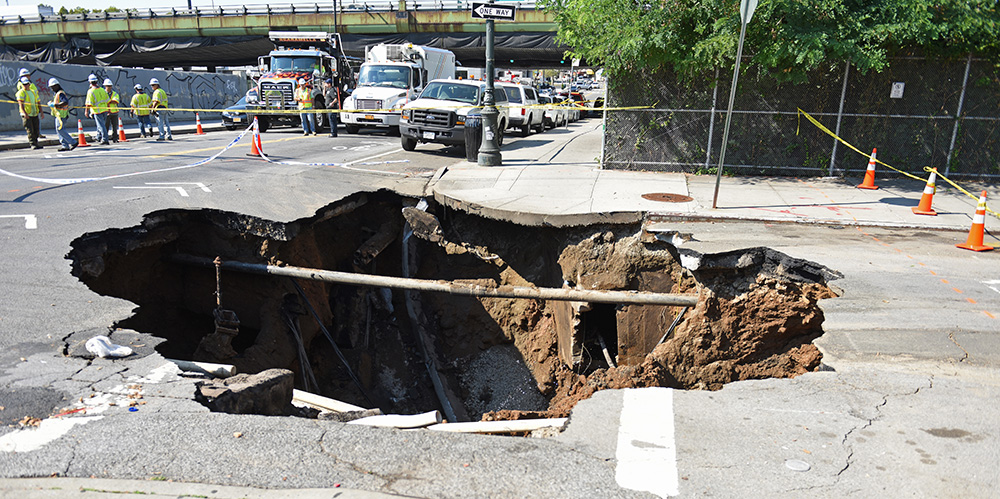Recent sinkhole in Norwich: what could be the cause?

In recent years, the term sinkhole is one that has become ever more common in our media headlines.
Defined by the Cambridge Dictionary as “a large hole that suddenly appears in the ground when the surface of the ground is no longer supported”1.
They are a menacing phenomenon that continue to cause disruption and damage to our road networks and property.
An important attributing factor to the occurrence of these sinkholes is the underlying geological bedrock. It relies almost entirely on dissolvable minerals being present for a void to be created and a sinkhole formed. Limestone is one of these minerals, a sedimentary rock made from calcium carbonate (CaCO₃).
We have seen a number of sinkholes reported in the last 12 months and after thorough investigation from the respective regional water companies, many have been associated with damaged water infrastructure.
As pipelines deteriorate and age, leaks can develop and ultimately lead to the material surrounding the pipes being washed away. In cases where the local geology contains dissolutional limestone or other soluble minerals, it can simply fall into solution.
This creates a void around the leaking pipe and in turn, means “the surface of the ground is no longer supported” as stated by Cambridge. Pressure and heavy loads upon this surface can lead to a hole opening up, revealing the extent of the void beneath and thus, a sinkhole appears in the media.
It should be noted that whilst damaged infrastructure does play a part in sinkhole development, there are natural causes too. For example, water passing through fissures into the soluble material following heavy rainfall, or as we are seeing more frequently with the effects of global climate change, rising sea levels. Equally, over long periods of time, groundwater flowing through the subsurface can dissolve the carbonate bedrocks, creating voids. These voids then allow groundwater to flow at a greater, more accelerated rate, this in itself making the water more erosive. These factors allow soil above the bedrock to collapse into the void, which in time, continues to erode from the inside, eventually migrating to the surface creating open holes.
A point to consider is how historic mining features can cause similar events. The collapse of mine workings do often get branded in the media as a sinkhole. However some schools of thought consider sinkholes to be merely naturally occurring phenomena, as such, mine workings may sit outside of this definition.
However, what is interesting is when you have sinkholes recorded in areas where there are historic mine workings for the extraction of chalk. Chalk is a form of limestone containing the mineral calcite, it is water soluble and is prone to the sort of dissolution discussed above.
If subterranean mine workings exist within these carbonate bedrocks, in their abandoned state they are but a passage through which water can flow, exacerbating the water’s erosive capabilities.
Consider this recent sinkhole in Norwich. On the 30th of July 2021 a small hole was spotted on the site of a previously investigated and treated sinkhole from 20182, where a woman’s car got trapped after her tyre dropped into the void. The cause of the original collapse was considered to be down to a broken cast iron pipe, much like that discussed previously.

But what’s interesting is when you overlay Groundsure’s historic mining data onto modern day Ordnance Survey mapping, you can see the original site of the 2018 sinkhole (depicted as a red diamond), this is the same location of the collapse on 30th July. Close to the south, are some recorded chalk mine workings of an unknown depth and are likely to date back to the 13th Century, connecting these to the surface are two recorded mine shafts. Our experience and other local examples tells us that there is likely more going on here than the historic sources depict, but due to the independent and unsystematic manner of the local mining operations, records are very poor and incomplete.
Norwich has a history of sinkholes and of collapses caused by ancient, sporadic and mostly unrecorded chalk mining activity. In the case of this sinkhole, the experts investigated and attributed it to damaged infrastructure, but so many around the city of Norwich have had a mining related cause.
This highlights something that we are often faced with when talking to people about mining risk. There is a common misconception that cities are not affected by mining, that it is a rural problem. That simply is not the case. Whether it be naturally occurring, a broken pipe or a collapsed mine working, these events can hold equal devastation for a homeowner.
Our Avista report includes a comprehensive alert to the likely presence of sinkholes. It covers recent sinkhole incidents in media reports, incidents recorded by the BGS and Stantec, and past incidents from Groundsure’s comprehensive archive. This dataset contains 75,000 recorded sinkhole incidents – the largest dataset available! Click here to find out more about our product: https://www.groundsure.com/products/avista/
References:
Date:
Aug 16, 2021
Author:
Tom Harvey-James

